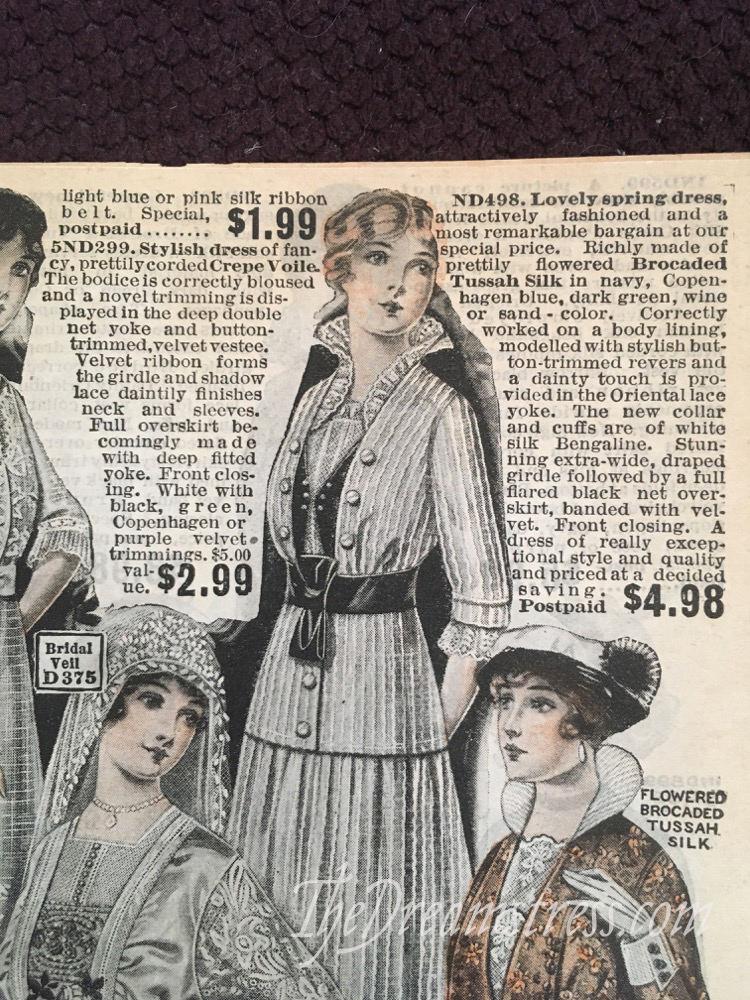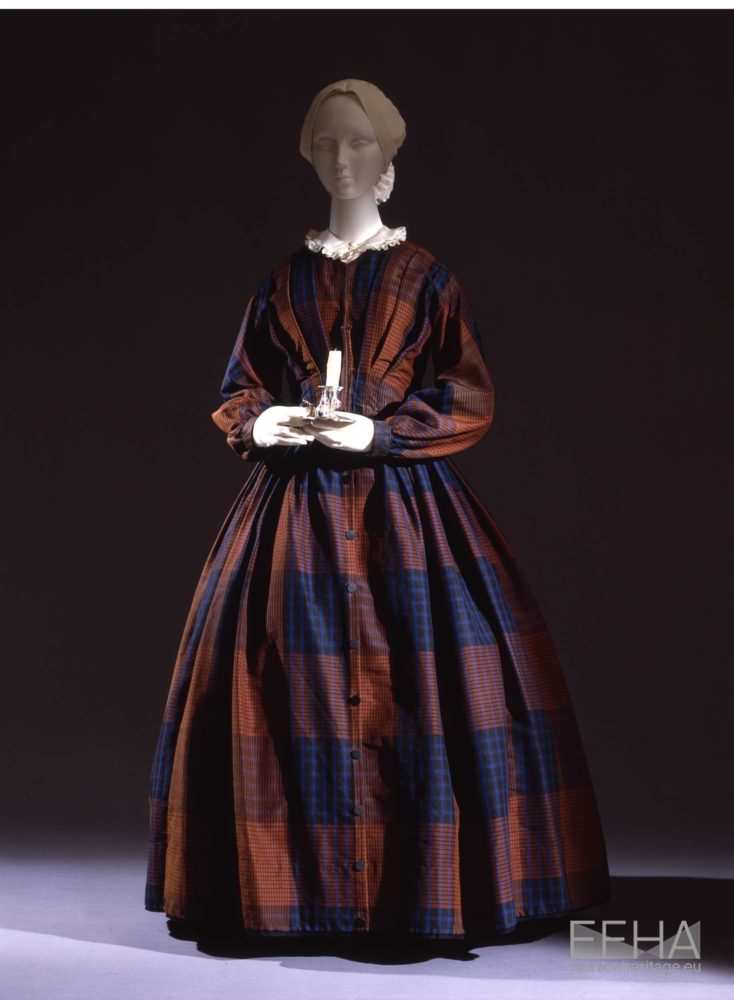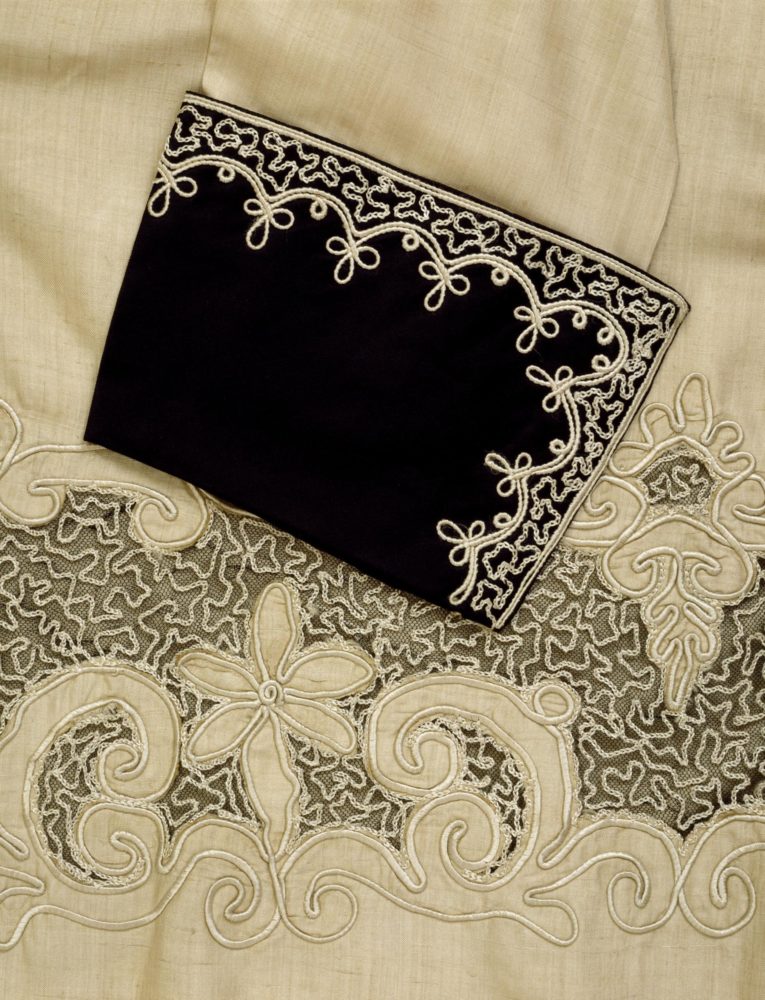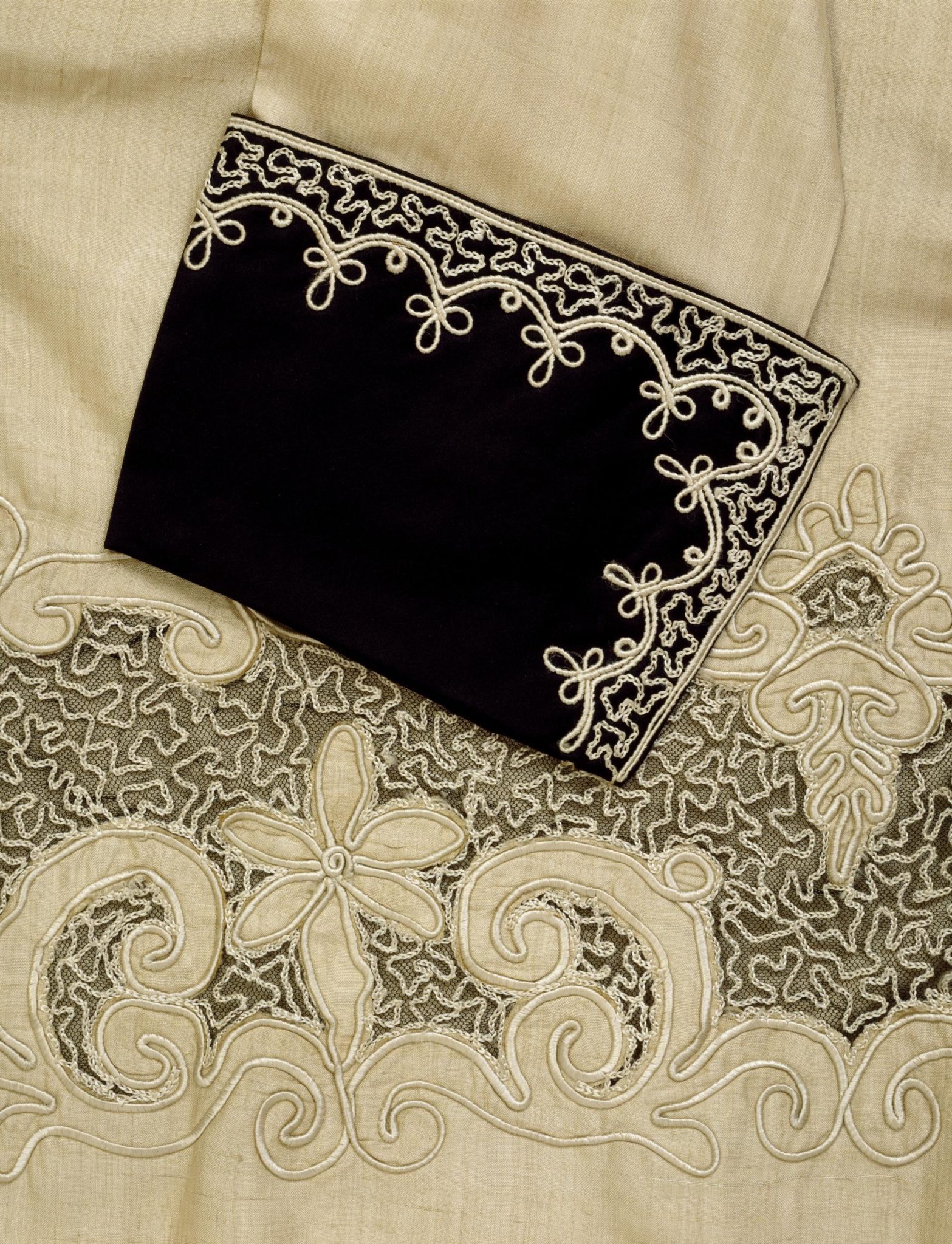This post didn’t start out as a terminology post! I was going to show you more images from my Spring 1915 Standard Mail order catalogue – and thought I would do some terminology explorations along with it.

I started writing about the dresses and the terms mentioned, and the post got longer, and longer, and longer… So I’ve cut it apart, and will just focus on one term: tussah silk. It’s featured in my least favourite dress on the page: the brown floral number with the ruched midriff.

Tussah Silk (also Tussar silk, Tushar silk, Tassar silk, Tusser silk or kosa silk)
Tussah silk comes from a variety of silkworms that eat oak leaves, and other leaves high in tannin, rather than mulberry leaves. The tannin in the leaves gives tussah silk its characteristic pale gold colour. The filaments of tussah silk are much thicker and stronger than standard silk, and are oval instead of round. Because the initial threads aren’t as fine, tussah silk cloth has a coarser hand than regular silk, and often has a slightly slub-y effect.
Tussah silkworms are significantly hardier than their delicate mulberry-fed cousins, and can survive much more easily in the wild. Due to the rougher texture of the silk, and the few wild populations of tussah silkworms that are harvested for silk, tussah silk is sometimes called ‘wild silk’, although the vast majority of it comes from farmed silkworms.
In 19th century fashion writing tussah often refers to the specific type of silk, and tussore to the slubbed look of the weave most associated with it: so tussah could be woven not in tussore style, or in tussore style.
To make this even more confusing, tussah silk fabric was sometimes called tussore linen, particularly in the 1870s, because its subtler sheen and slightly rough finish meant it was considered more suitable for the type of informal summer clothes that linen was made out of than the more formal styles of silk. Very annoyingly as a researcher, a rough calico was also sometimes called tussore cloth, as was a linen-cotton blend, and maybe hemp or piña cloth (the references to Indian pine are quite confusing), and linen in the specific golden shade characteristic of tussore silk. Today slubbed linen is also called tussore linen, and while some references are clearly one are the other (this one’s obviously silk, and I’m pretty sure this one’s linen, but maybe not?), many are not, and its impossible to tell if the fabric in question was a linen or a silk.
Tussah silk has been used in China, India and Southeast Asia for centuries. It begins to show up in Western fashion on a regular basis from the 1850s onwards, probably because of England’s increased control of India after the rebellion of 1857 and increased influence in China following the first & Second Opium War, and Japan’s forced opening up to the rest of the world.
This dress (possibly a wrapper) is one of the earliest examples I’m aware of a Western garment in tussah silk:

In the 1860s and 70s tussah was considered a luxury fibre, and was clearly singled out from standard silk. However, it was also an informal fibre: used for summer day wear, and accessories like parasols, and never for evening or formal wear.

After its initial novelty popularity wore off, the use of tussah was confined almost exclusively to sportwear.
This tennis dress is an excellent example of the use of tussah silk for sportswear. Elegant, casual, and supremely expensive, this outfit is the modern equivalent of designer yoga gear: it says without words that you can spend money on clothes to sweat in.

Powerhouse Museum, H6536
Even when it was out of fashion elsewhere, tussah silk was widely used by the Arts & Crafts movement, the aesthetic dress movement and design houses like Liberty of London.
This dress by Raymond Duncan (brother of Isadora), is a later example of the link between alternative dress movements and tussah silk. It uses the natural golden colour,and slight slubs of tussah silk, to enhance the antique and bohemian aesthetic of his design. Duncan was an almost fanatical proponent of a return to Grecian styles. He believed they were healthier and more attractive than the fashions of the time.

Metropolitan Museum of Art, 990.152

Having been relegated to very informal clothing & fringe fashion for a couple of decades, tussah returned to popularity at the end of the 19th century, as in this fashion article where the author gushes over the shades of tan it comes in, the delicate brocading (like the dress I dislike so much!), and its rescue from ‘homespun’! Another fashion writer compares it to pongee, and gives advice on how to trim it.
Although fashionable again, tussah silk was still primarily used as a linen alternative in the Edwardian era, as in this elegant dust coat.

By the mid-teens, the era of my magazine, tussah silk had by and large lost its outsider status, and was being used for a wider range of garments, though still exclusively for daywear. Thanks to the influence of Poiret, the Ballet Russes etc, anything exotic was in.
Tussah continued to be a popular fabric into the 1920s. It fit in with the fashion for rough and textured fabrics, like roshanara. It had also lost its high price tag: tussah silk appears as a lining in a number of 20s garments that I’ve seen in museum collections, suggesting it was an affordable silk.
Tussah silk should not be confused with silk noil (the rough silk made from the short bits of leftover silk fibres) (looks pointedly at Understanding Textiles on this point), or raw silk (silk with the gum left on).
Some tussah silk is “ethical silk” “non-violent silk” or “Ahimsa silk“, in that the silkworms are not killed to create the silk, but that’s not traditionally part of the tussah silk process, and unless labelled as such tussah silk is unlikely to be “non-violent”.
Very annoyingly, I carefully packed the three pieces of tussah silk I own away at the bottom of a trunk in vacuum sealed bags just today! The next time I have cause to get in the bags I’ll photograph them for this post.
Sources:
- Basu, Trailokya Nath. Tant-o-rang: A Book of Textile Technology. 1964
- Cant, Jennifer and Fritz, Anne. Consumer Textiles. Melbourne: Oxford University Press. 1988.
- Collier, Billie J. and Tortora, Phyllis G.. Understanding Textiles. 6th ed. Sydney: Prentice Hall. 2001.
- O’Hara, Georgina, The Encyclopedia of Fashion: From 1840 to the 1980s. London: Thames and Hudson Ltd. 1986
- Phipps, Elena. Looking at Textiles: a Guide to Technical Terms. Los Angeles: Getty Museum. 2011
- Pickens, Mary Brooks, A Dictionary of Costume and Fashion: Historical and Modern. Mineola New York: Dover Publications. 1985 (originally published as The Fashion Dictionary. New York: Funk & Wagnalls. 1957)


This is so interesting! I don’t know if I’ve ever encountered tussah in the wild 😉 Is the hand similar to a shantung, or is it softer, like a silk broadcloth?
Thanks for this post – fabric terminology is pretty much my favorite thing ever!
informative! i love that edwardian duster coat…gorgeous piece. and i’m even fond of the duncan design.
i wear a fair amount of india-made shalwar kameez sets, and the thin chanderi silk tops need a liner kurti, which if included, is invariably of cotton. but when ordered separately, tussar silk is one of the usual options. i wonder if that is a traditional lining/undergarment choice in india? it makes sense; given its normal tan colour, it would be less prone to discolouration from sweating, and could be washed with the same technique as other silk garments. that very spendy tussar tennis ensemble might have been rather practical in certain ways, along with its conspicuous consumption aspect…less readily stained with sweat and dust, breathable (more than cotton, in my experience), finer and softer tan most linen, and tougher than it looks.
thanks for an interesting article.
I’ve got a bag of tussah silk top here to spin, it’s one of my favourite fibres to work with for spinning as it also blends really well with other fibres. I once spun a heap of baby alpaca that I blended with tussah silk and the natural shades worked so well together. You can get it bleached and unbleached, mine’s unbleached.
This is super interesting thank you!! I’ve only ever enjoyed it and it deserves some understanding too.
I love it so much, the colour is so dreamy. The first wedding dress I ever made was out of tussah, with a bodice crocheted from hand spun tussah (I didn’t do the crochet though)
That was in 1982, when Gees Silks in Newtown sold all sorts of silks by the metre from paj and habotai to jacquards and tussah. They mostly sold tablewear and accessories made from silk though. So to me I’ve always associated it with China and useful things, not India and glamorous Dupion (well it WAS the 80s!)
Ooh, I would love to wear that possibly-a-wrapper dress! Especially if it is a wrapper.
Now I’m wondering if my wedding dress is made of tussah silk. I see a faint golden tinge to it, and it’s fairly rough and slubby. No idea when it was made or who by (I acquired it about 15 years ago from the Christchurch City Mission) but it appears to be partly handsewn and partly machine sewn, lined with something which I suspect is white polyester (possibly a later addition?), and with dozens of little covered buttons all down the back and at the cuffs.
Fascinating. Particularly the tricky nomenclature.
And on that topic, perhaps the sister was Isadora Duncan, rather than Isabella?
Ah, thank you! I knew it wasn’t right in my head as I typed it, but forgot to go back and check.
You know I always love terminology posts. 😉 And this definitely helps clear up some things considering silks…
Excellent article, well researched too. It’s information such as this that I want to know. It adds so much more to our historical costuming adventure to understand the textiles, tools, construction methods, and even the commercial trade and marketing methods. Thanks, and please keep the articles coming!
Interesting. I didn’t know there were non-mulberry silkworms. Also, that tennis dress is charming!
I was given 7m of arsenically green tussah silk a a gift. Tremendously tough,broke my sewing machine, had to finish the gown with leather needles and plyers.
When I started at my posh girl’s day school back in 1976, on the uniform list the blouse was referred to as “Tussah coloured” which meant in practice a sort of pale straw colour cotton. My mother supposed that it was because the school blouses had originally been made of tussah silk, and seeing that tennis outfit and reading the comments above, I think it may have been so.
Great post!
In the clothing collections here in Bury St Edmunds, Suffolk, UK, there is a tussah silk dress and jacket in a cream colour, of 1925, worn by an English doctor in Egypt. Described as being made of ‘washing silk’, it being so hot there that a maid could wash it and iron it. So perhaps the tennis dress was possibly laundered?
Thank you for the lesson!
I just acquired 10 yards of vintage silk tussah from the 1970’s and am excited to feel it but very nervous to cut it!
Will you be doing an article on silk noil?